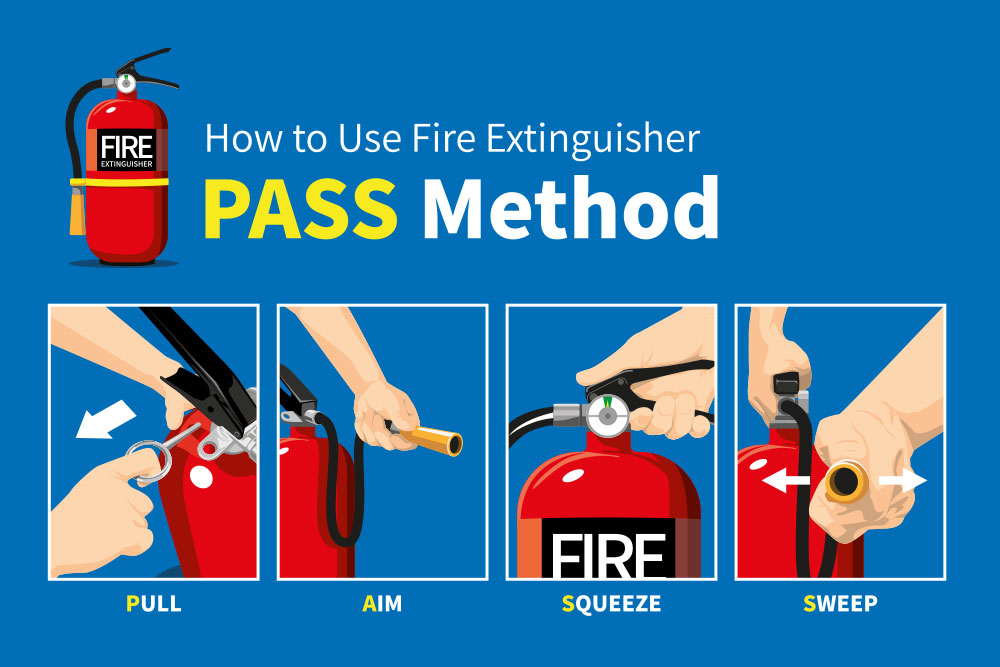
You might not realise it, but there is a proper way to use a fire extinguisher. The PASS technique is an easy-to-remember method for effectively using a fire extinguisher.
But what does PASS stand for and why is it so critical for fire safety in the workplace? Keep reading to discover how PASS can give you the perfect fire extinguisher technique when it matters most.
Why Fire Extinguishers are Important for Fire Safety in the Workplace
Fires can start in seconds and tear through a building in just minutes. You may only have a small window of opportunity to put out a fire once it’s begun.
If a fire does break out, a fire extinguisher is often the first line of defence. The number of fires in the UK that were put out using portable fire extinguishers rose from 80% in 2003 to 93% in 2021.
Legally, a business owner must have firefighting equipment on their premises and ensure it is kept in good working order. This is mandated under the Regulatory Reform (Fire Safety Order) 2005 (RRO).
Sadly, many don’t know how to use firefighting equipment or what to do if a fire starts. According to a recent survey, about 85% of tradespeople in the UK don’t know what they should do during a fire. That’s almost one in every ten.
Most people assume that using a fire extinguisher is as simple as grabbing it, pointing it at a fire and letting it rip. But this isn’t quite the case. Fire extinguishers aren’t simply point-and-click devices. To be effective, you must use the correct technique and extinguisher.
What Does PASS Stand For?
Being able to react calmly and quickly in an emergency is crucial. Knowing the PASS mnemonic will ensure that you can recall the correct way to use a fire extinguisher when the pressure is on. But what does PASS stand for in fire safety?
PASS stands for:
- Pull
- Aim
- Squeeze
- Sweep
Let’s take a look at each of these steps in greater detail.
Pull
When using a fire extinguisher, the first action is to pull out the safety pin in the handle. This will allow you to depress the handle and activate the extinguisher.
Aim
Next, you need to take aim at the fire. Cautiously approach the fire and ready the extinguisher. Always point the nozzle or the outlet of the fire extinguisher toward the base of the flames. If you aim too high, then the spray from the extinguisher may not properly suppress the source of the blaze.
Squeeze
Squeeze the trigger on the extinguisher’s handle slowly, firmly, and evenly. Depress it and point the extinguisher at the flames until it is empty.
Sweep
While the extinguisher releases its contents, sweep it from side to side across the base area of the fire. If the fire does go out, but there are still contents in the extinguisher, keep sweeping the base until the extinguisher is empty. This will stop the fire from reigniting.

Note: The PASS technique applies to most fires, but it should not be used for oil or fat fires. The force of a standard extinguisher can spread burning liquid, making the fire worse. A fire blanket is often a safer option, though a wet chemical extinguisher is recommended for larger cooking oil fires.
Not all Fire Extinguishers Are the Same
The PASS technique is a helpful method for using fire extinguishers, but it is just one part of fire safety. It’s important to understand the different types of extinguishers and how to use them correctly.
Extinguishers are designed for specific fire types. Before using an extinguisher, check its rating. Extinguishers are designed for specific fire types, such as A, B, C, D, F, or electrical. Using the wrong one can make the situation worse or even spread the fire.
Every workplace should have the correct type of extinguisher for relevant fire hazards. Size matters, too. Large areas may need bigger extinguishers, while smaller ones are obviously better suited for compact spaces.
So, never attempt to extinguish a fire unless you have been trained and understand the type of fire and the extinguisher you’re using.
Your safety and ability to escape should always come first. A fire extinguisher can help stop a small fire from spreading, but there will be times when it’s not safe to intervene. Knowing when to act and when to evacuate is critical.
Learning how to use an extinguisher properly and practising with one in a controlled setting will give you the skills to respond effectively. Without training, using an extinguisher in an emergency is not recommended.
Please note: You should only use a fire extinguisher to fight a fire if you are sure it’s safe to do so and you have a good chance of putting the fire out. Otherwise, follow the correct fire emergency procedures, exit the building and alert the authorities.
Real-World Examples of the PASS Technique
Given proper training, understanding PASS can save lives and property. Take the recent case of 56-year-old filling station attendant Debbie Swinson. Debbie used a fire extinguisher to save a man’s life after he caught fire at a fuel pump.
Debbie’s proficiency with PASS enabled her to douse the flames before emergency services arrived, prevent further injury, and stop the fire from spreading further.
Another example of good fire extinguisher use was when Paul Fulton, the head janitor of the Newark Primary School, extinguished a blaze set by vandals and saved the school from considerable damage.
Although off-duty at the time. Paul saw smoke and was able to put out a burning tyre with a nearby fire extinguisher, effectively stopping the blaze from damaging the school equipment and grounds.
This was the second time Paul had to use a fire extinguisher to extinguish a fire that was started intentionally. The first incident involved a fire on the school’s sports pitches. Paul had to use three fire extinguishers to get the blaze under control.
Debbie and Paul show why having the correct fire extinguisher technique is crucial in an emergency. If you have the perfect PASS technique, you might be able to wield a fire extinguisher as decisively as they did.
Why Fire Extinguisher Training is Critical
Knowing how to use a fire extinguisher properly could help stop a fire from destroying your business and possibly even save someone’s life.
Our Fire Extinguisher Training course will teach you and your team how to use fire extinguishers correctly and effectively. The course can be taken online and runs for approximately half an hour.
































































































































































































































































































































































































































































































































































































































































































































































